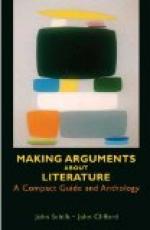All reasoning thus reduces itself in the end to a process of passing from like to like: we notice that the present case is like other cases which we already know: then, since these cases have always in the past been accompanied by certain circumstances or consequences, we believe that the present case will also show these same circumstances or consequences. Whenever my dog has killed when the cases have been similar in the blood and feathers on his mouth; in this case he has blood and feathers on his mouth; therefore he must have killed a hen. Individual plants and animals survive which are fitted to their environment by special characteristics, and those which are not so fitted die; species of plants and animals, as well as individuals, show special adaptation to their environment; therefore species have survived through the same process of natural selection.
It follows that reasoning, whether it results in a general law or in concrete judgment, depends on the assumption that nature—and in nature we mean here the whole universe as we know it is uniform; that there are ties between facts which make it possible for us to be certain that if a given fact occurs, then another fact always occurs with it as an effect, or as a cause, or connected with it in some other manner. Without this certainty of the uniformity of things there would be no reasoning, and therefore no argument from indirect evidence. Huxley sets forth this fundamental truth clearly and impressively at the beginning of the first of his “Lectures on Evolution” (see p. 234).
For practical purposes the various types of this inference from similarity can be conveniently thrown into three groups. As will be obvious, there is no fixed and impassable line between them.
“If an inference relies upon a resemblance that is newly seen, rare, or doubtful, it is called an inference from analogy; if it is made upon the basis of an established classification, it is called a generalization; if it involves a variety of resemblances so combined as to bear upon a single point, it is usually or frequently called an inference from circumstantial evidence."[25]
I will take up each of these types and show how we use them in the practical work of argument. It will be seen that they vary greatly in certainty of results.
34. Reasoning from Analogy. Analogy in its most tenuous form is weak as a basis for an actual inference, though it is often effective as a means of expressing an intuitive judgment where the reasons are too subtle and diffused for formal explanation. When Lincoln in the middle of the Civil War said that men do not swap horses while they are crossing a stream, the analog, though subtle, was felt to be real. Popular adages and proverbs are common modes of expressing such deep-lying analogies: for example, “Where there is smoke there is fire”; “The slothful man saith, There is a lion in the way.” Poetry too is full of these subtle, pregnant similarities which link things in some one aspect, but fail for all others.




